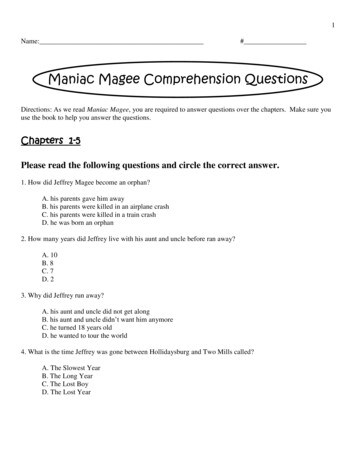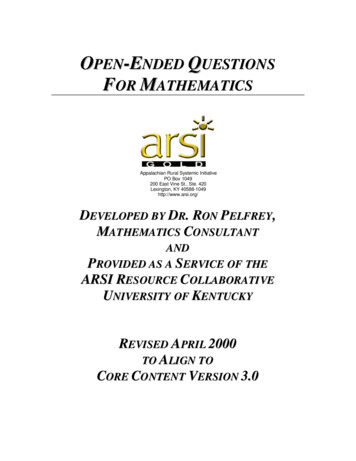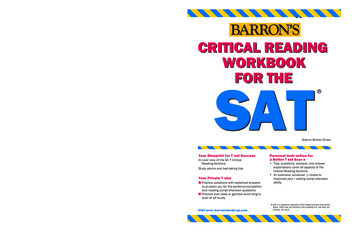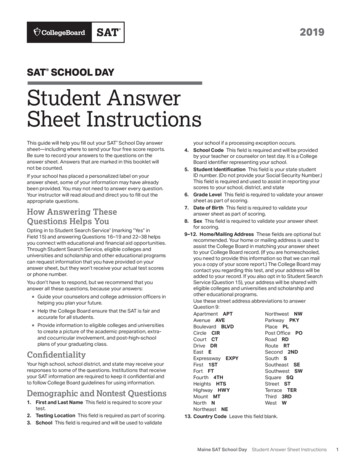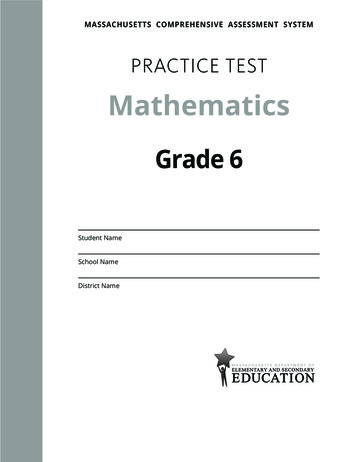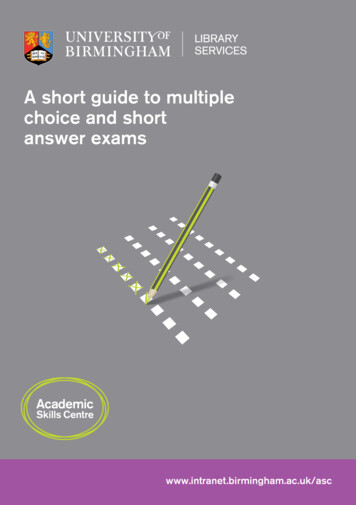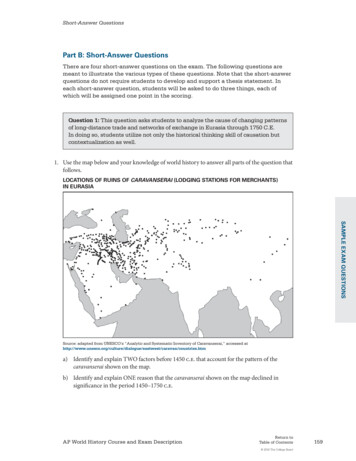
Transcription
Short-Answer QuestionsPart B: Short-Answer QuestionsThere are four short-answer questions on the exam. The following questions aremeant to illustrate the various types of these questions. Note that the short-answerquestions do not require students to develop and support a thesis statement. Ineach short-answer question, students will be asked to do three things, each ofwhich will be assigned one point in the scoring.Question 1: This question asks students to analyze the cause of changing patternsof long-distance trade and networks of exchange in Eurasia through 1750 C.E.In doing so, students utilize not only the historical thinking skill of causation butcontextualization as well.1. Use the map below and your knowledge of world history to answer all parts of the question thatfollows.LOCATIONS OF RUINS OF CARAVANSERAI (LODGING STATIONS FOR mERCHANTS)IN EURASIASample Exam QuestionsSource: adapted from UNESCO’s “Analytic and Systematic Inventory of Caravanserai,” accessed caravan/countries.htma) Identify and explain TWO factors before 1450 c.e. that account for the pattern of thecaravanserai shown on the map.b) Identify and explain ONE reason that the caravanserai shown on the map declined insignificance in the period 1450–1750 c.e.AP World History Course and Exam DescriptionReturn toTable of Contents 2016 The College Board159
Short-Answer QuestionsLearning ObjectivesCUL-3 Explain how major philosophies and ideologiesdeveloped and spread as a result of expandingcommunication and exchange networks.HistoricalThinking SkillsKey Conceptsin the 3.1.III4.1.IIIECON-12 Evaluate how and to what extent networks ofexchange have expanded, contracted, or changed over time.4.1.IVECON-13 Analyze how international economic institutions,regional trade agreements, and corporations–both local andmultinational–have interacted with state economic authority.What good responses will includeSample Exam QuestionsA good response will provide and explain two factors that account for the spatialpatterns of the spread of the caravanserai before 1450 C.E. Such factors mightinclude the improved transportation technologies and commercial practices that ledto an increased volume and geographic expansion of trade, as well as the expansionof empires, such as the caliphates and the Mongols, that facilitated Eurasian tradeand drew new peoples and places into trade networks. A good response must alsobriefly explain the decline of these overland trade routes after 1450 C.E. due to, forexample, the growing volume of maritime trade facilitated by European traders andjoint-stock companies that used American silver to purchase Asian goods.Question 2: This question addresses state expansion and consolidation duringthe period 1450 C.E. to 1750 C.E. In responding to the question, students mustanalyze the actions and practices of rulers, and shifts and developments of politicalinstitutions, within a concrete historical context.2. Answer all parts of the question that follows.Identify and explain THREE ways in which rulers legitimized or consolidated their power duringthe period 1450 c.e. to 1750 c.e. Use specific examples from one or more states or empires.Learning ObjectivesCUL-4 Analyze the ways in which religious and secular beliefsystems affected political, economic, and social institutions.HistoricalThinking SkillKey Conceptin the CurriculumFrameworkContextualization4.3.ISB-1 Explain and compare how rulers constructedand maintained different forms of governance.SB-2 Analyze how the functions and institutionsof governments have changed over time.SB-4 Explain and compare how social, cultural,and environmental factors influenced stateformation, expansion, and dissolution.AP World History Course and Exam DescriptionReturn toTable of Contents 2016 The College Board160
Short-Answer QuestionsLearning ObjectivesHistoricalThinking SkillKey Conceptin the CurriculumFrameworkSB-5 Assess the degree to which the functions of citieswithin states or empires have changed over time.SB-7 Assess how and why internal conflicts, such asrevolts and revolutions, have influenced the processof state building, expansion, and dissolution.SB-9 Assess how and why commercialexchanges have influenced the processes ofstate building, expansion, and dissolution.SB-10 Analyze the political and economic interactionsbetween states and non-state actors.ECON-3 Assess the economic strategies ofdifferent types of states and empires.ECON-8 Analyze the relationship betweenbelief systems and economic systems.SOC-3 Assess the impact that different ideologies,philosophies, and religions had on social stratification.SOC-5 Analyze ways in which religious beliefsand practices have sustained or challengedclass, gender, and racial ideologies.Sample Exam QuestionsSOC-7 Analyze the ways in which colonialism, nationalism,and independence movements have sustained orchallenged class, gender, and racial ideologies.What good responses will includeIn a good response, students identify and explain three distinct ways that rulerslegitimized or consolidated power. One example might be the use of religion, art,and architecture (such as that associated with the Mughal Empire) as meansto legitimize rule. Students might also explain how states such as the OttomanEmpire utilized specific ethnic and religious groups for economic contributionswhile limiting their ability to challenge the authority of the state. A brief discussionof the growth of professional administrative bureaucracies and armies in placessuch as Tokugawa Japan would also be an appropriate means for explaining stateconsolidation in this period. Students can chose to provide their examples from oneor more states and empires.AP World History Course and Exam DescriptionReturn toTable of Contents 2016 The College Board161
Short-Answer QuestionsQuestion 3: This question addresses the development of industrialization,nationalism, and imperialism outside of Europe between the late 19th centuryand World War II. Focusing on Japan, students are required to analyze thesedevelopments through the lens of causation, and continuity and change.3. Use the artwork below and your knowledge of world history to answer all parts of the questionthat follows.Sample Exam QuestionsImage Courtesy of the British Librarya) Identify and explain ONE factor that enabled Japan to develop the military capacityalluded to in the painting.b) Identify and explain ONE way in which the painting reflects the development of newcultural identities in the nineteenth century.c) Identify and explain ONE way in which Japanese militarism affected international politicsin the period circa 1900–1945.AP World History Course and Exam DescriptionReturn toTable of Contents 2016 The College Board162
Short-Answer QuestionsLearning ObjectivesSB-1 Explain and compare how rulers constructedand maintained different forms of governance.SB-4 Explain and compare how social, cultural,and environmental factors influenced stateformation, expansion, and dissolution.HistoricalThinking SkillsKey Conceptsin the CurriculumFrameworkCausation5.1.VContinuityand Change5.2.IIContextualization5.3.II6.2.IVSB-8 Assess how and why external conflictsand alliances have influenced the process ofstate building, expansion, and dissolution.SB-9 Assess how and why commercialexchanges have influenced the processes ofstate building, expansion, and dissolution.ECON-4 Analyze how technology shaped theprocesses of industrialization and globalization.What Good Responses Will IncludeSample Exam QuestionsA good response must briefly relate the Meiji Restoration and industrializationto Japan’s expanding military and imperial capacities in the late 19th century. Inaddition, students must contextualize Toshikata’s painting and provide specificevidence from it (e.g., Western-style military uniforms) that demonstrates the impactof modernity upon changes and continuities in Japanese national identity duringthis period. Finally, students must also briefly identify and explain a consequence ofJapanese militarism upon international politics in the first half of the 20th century.For example, students might analyze the impact of the Russo-Japanese War (19041905) upon the Russian Revolution, or the expansion of Japanese imperialism andmilitarism in the 1930s as contributing to the origins of World War II.Question 4: Students must analyze the differing interpretations of historians RonaldPowaski and Ralph Levering about the origins of the Cold War. They must identifyand explain historical evidence that substantiates the arguments of both historians.4. Use the two passages below and your knowledge of world history to answer all parts of thequestion that follows.Source 1:“It seems, in hindsight, that the Cold War was inevitable. From the very beginning of the RussianAmerican relationship, the ideologies of the two nations were fundamentally incompatible.Founded in 1776, the young United States was republican and democratic. Russia, on the otherhand, was an old autocracy, hostile to democracy, xenophobic, and known for ruthless suppressionof its numerous subjects. There was another factor that seemed to make eventual conflict betweenthe two nations inevitable: both were expansionist states whose respective spheres of interest wouldeventually expand to global dimensions.”Ronald E. Powaski, The Cold War: The United States andthe Soviet Union, 1917–1991, 1998AP World History Course and Exam DescriptionReturn toTable of Contents 2016 The College Board163
Short-Answer QuestionsSource 2:“Some scholars argue that the Cold War began in 1917–1920 with the first ideological, political,and military clashes between the U.S.S.R. and the West. But most scholars believe that it makesmore sense to place the start of the Cold War in the mid-1940s when American and Soviet leadershad the military power, the economic resources, and the determination to engage in a far-flung andintense ideological, political, military, and cultural struggle for influence.”Ralph Levering, Debating the Origins of the Cold War:American and Russian Perspectives, 2001a) Identify and explain ONE piece of historical evidence that would support Powaski’sinterpretation about the origins of the Cold War.b) Identify and explain ONE piece of historical evidence that would support Levering’sinterpretation about the origins of the Cold War.c) From the two interpretations above, select the one that, in your opinion, better accountsfor the origins of the Cold War. Briefly explain your choice using additional evidencebeyond that used to answer a or b.Learning ObjectiveKey Conceptin the CurriculumFrameworkArgumentation6.2.IVSample Exam QuestionsSB-8 Assess how and why external conflictsand alliances have influenced the process ofstate building, expansion, and dissolution.HistoricalThinking SkillsAnalyzingEvidence: Contentand SourcingInterpretationWhat Good Responses Will IncludeA good response must identify and explain how a specific piece of historicalevidence supports Powaski’s interpretation of the origins of the Cold War. Forexample, a student might substantiate Powaski’s argument about the early andinevitable ideological and political origins of the Cold War by analyzing examplessuch as the Comintern and the First Red Scare in this regard. Students mightalso provide evidence that supports Powaski’s claim that both the United Statesand Russia were expansionist states and briefly analyze examples of Americanimperialism and Soviet expansion before World War II. Students must supportLevering’s interpretation, and a good response might identify and explain how theCuban Missile Crisis, or the U.S. and Soviet supported proxy wars that developedbetween and within postcolonial states, evidenced the far-flung and post-WorldWar II origins and dimensions of the Cold War. In weighing the relative strengthof the two arguments, a good response might present and explain evidence thatchallenges the argument of one of the historians. For example, in challengingPowaski, a student might identify and explain the impact and contingencyof nuclear rivalry initiated in the mid-1940s as a key and essential cause andcomponent of the Cold War.AP World History Course and Exam DescriptionReturn toTable of Contents 2016 The College Board164
Document-Based QuestionSection IIPart A: Document-Based QuestionThere will be one document-based question on the exam. The document-basedquestion will have one of the following historical thinking skills as its mainfocus: comparison, causation, patterns of continuity and change over time, orperiodization. In addition, all document-based questions will always assess thehistorical thinking skills of argumentation, analyzing evidence, contextualization,and synthesis.In the sample question shown that follows, the main historical thinking skill beingassessed is comparison (actual document-based questions on the exams may focuson other skills); in employing this skill, students will also use the skill of patterns ofcontinuity and change over time. The learning objectives addressed in this sampledocument-based question are primarily from Theme 4: Creation, Expansion, andInteraction of Economic Systems (ECON). The directions to students will explain thediscrete tasks necessary to score well on this question.Sample Exam QuestionsAP World History Course and Exam DescriptionReturn toTable of Contents 2016 The College Board165
Document-Based QuestionWORLD HISTORY SECTION IITotal Time—1 hour, 30 minutesQuestion 1 (Document-Based Question)Suggested reading and writing time: 55 minutesIt is suggested that you spend 15 minutes reading the documents and 40 minutes writing yourresponse.Note: You may begin writing your response before the reading period is over.Directions: Question 1 is based on the accompanying documents. The documents have been editedfor the purpose of this exercise.In your response you should do the following. Thesis: Present a thesis that makes a historically defensible claim and responds to all parts ofthe question. The thesis must consist of one or more sentences located in one place, either in theintroduction or the conclusion. Argument Development: Develop and support a cohesive argument that recognizes andaccounts for historical complexity by explicitly illustrating relationships among historicalevidence such as contradiction, corroboration, and/or qualification.Sample Exam Questions Use of the Documents: Utilize the content of at least six of the documents to support the statedthesis or a relevant argument. Sourcing the Documents: Explain the significance of the author’s point of view, author’spurpose, historical context, and/or audience for at least four documents. Contextualization: Situate the argument by explaining the broader historical events,developments, or processes immediately relevant to the question. Outside Evidence: Provide an example or additional piece of specific evidence beyond thosefound in the documents to support or qualify the argument. Synthesis: Extend the argument by explaining the connections between the argument andONE of the following.– A development in a different historical period, situation, era, or geographical area– A course theme and/or approach to history that is not the focus of the essay (such aspolitical, economic, social, cultural, or intellectual history)– A different discipline or field of inquiry (such as economics, government and politics, arthistory, or anthropology)AP World History Course and Exam DescriptionReturn toTable of Contents 2016 The College Board166
Document-Based QuestionQuestion 1: Using the documents and your knowledge of world history, compareindustrialization in Japan and Russia between 1850 and 1914.Document 1Source: Sergey Witte, Russian finance minister, secret letter to Tsar Nicholas II, 1899.The entire economic structure of the empire has been transformed in the course of the secondhalf of the current century, so that now the market and its price structure represent thecollective interest of all private enterprises which constitute our national economy. Buying andselling and wage labor penetrate now into much deeper layers of our national existence thanwas the case at the time of serf economy . . .I realized, of course, that there were very weighty arguments against the protectionist systemand against high tariffs. But I supposed that even the proponents of free trade must be awarethat it would be extremely harmful from the government viewpoint to remove the protectivesystem before those industries had been securely established for whose creation wholegenerations had paid by a high tariff.The gradual growth of industry in the country, always accompanied by falling prices formanufactured goods, will make it possible for our export trade to deal not only in rawmaterials, as at present, but also in industrial goods. Our present losses in the European tradecan then be converted into profits in the Asiatic trade.Sample Exam QuestionsThe influx of foreign capital is, in my considered opinion, the sole means by which ourindustry can speedily furnish our country with abundant and cheap goods. Each new wave ofcapital, swept in from abroad, knocks down the high level of profits to which our monopolisticentrepreneurs are accustomed and forces them to seek compensation in technicalimprovements, which, in turn, will lead to price reductions.If we carry our commercial and industrial system, begun in the reign of Alexander III,consistently to the end, then Russia will at last come of age economically. Then her prosperity,her trade and finance, will be based on two reliable pillars, agriculture and industry; and therelations between them, profitable to both, will be the chief motive power in our economy.AP World History Course and Exam DescriptionReturn toTable of Contents 2016 The College Board167
Document-Based QuestionDocument 2Source: Count Okuma Shigenobu, former prime minister of Japan, “The IndustrialRevolution in Japan,” article published in a United States magazine, 1900.One of the principal measures adopted by the Meiji government, with the object of promotingthe national prosperity and enlightenment, was the education of the young as well as of grownmen, some of whom held high government positions. These latter were made to travel throughcivilized countries for the purpose of observing and examining their social, industrial, andpolitical institutions, with a view to transplanting to Japanese soil whatever seemed to themlikely to bear good fruit there.Another measure which the government steadily pursued was the establishment of variouskinds of factories, under the direct supervision and management of its officials. In the Schoolof Mechanical Engineering, a small iron-foundry was built, and machines were made for thepurpose of practical instruction. The Department of the Army started the manufacture ofgun-powder and implements of war, while the Department of the Navy built and equippeda dockyard. The Department of Finance . . . also felt the need of an establishment where thepaper currency, the national bonds and various kinds of stamps could be printed, and foundedone under its direct control. In a similar manner a paper factory was established . . . Thusvarious manufactures sprang up, one after another.AP World History Course and Exam DescriptionReturn toTable of Contents 2016 The College BoardSample Exam QuestionsThe government also encouraged the introduction of the machinery for reeling silk threadand spinning cotton yarns, both of which operations had formerly been done almost whollyby manual labor. The government succeeded in concentrating the capital until now scatteredby issuing Bank Regulations and establishing national banks. For the purpose of facilitatingforeign trade, it used its influence for the establishment of the Bank of Yokohama. Again, thegovernment undertook the construction of the first railway in Japan.168
Document-Based QuestionDocument 3Source: Julian Cochrane, photographer employed by a United States company thatdistributed photos for educational books, silk factory in central Japan, 1904.Sample Exam QuestionsCourtesy of www.MeijiShowa.comAP World History Course and Exam DescriptionReturn toTable of Contents 2016 The College Board169
Document-Based QuestionDocument 4Source: S. I. Somov, Russian socialist, memoirs published in 1907, recalling his participationin the 1904–1905 strike at the Putilov factory in Saint Petersburg.I remember the enormous impression which the first workers’ meeting [during the strike]produced on me and my comrades. A kind of mystical, religious ecstasy reigned the wholetime at the meeting; thousands of people stood side by side for hours in the dreadful heat [ofthe factory floor] and thirstily devoured the artless, strikingly powerful, simple, and passionatespeeches of their exhausted fellow workers. The whole time the content of the speeches wasmeager, the same phrases being repeated in many ways: “our patience has come to an end,”“our suffering has gone beyond all measure,” “better death than this life,” and so forth. Butthey were all pronounced with such marvelous, touching sincerity, flowed so much from thevery depths of an exhausted human soul, that the same phrase, pronounced for the hundredthtime, brought tears to the eyes, and conveyed the certainty that it was really necessary todo something in order to give vent to this worker bitterness and dissatisfaction, which hadoverflowed its limits.Document 5Sample Exam QuestionsSource: Yamamoto Shigemi, Japanese historian, interviews with elderly Japanese women whohad worked in silk factories in eastern Japan in the early 1900s, published in 1968.SURAspect of life in the silk FactoriesWorkers’ impressionsFoodPoor: 0%Average: 10%Good: 90%Nature of workHard: 3%Average: 75%Easy: 22%Pay compared to other workLower: 0%Average: 30%Good: 70%Treatment of sick workersPoor: 40%Average: 50%Good: 10%Asked if they were glad they hadgone to work in a silk factoryNot glad: 0%Neutral: 10%Glad: 90%AP World History Course and Exam DescriptionReturn toTable of Contents 2016 The College Board170
Document-Based QuestionDocument 6Source: Pavel Buryshkin, Russian merchant, from his published memoirs, written between1911 and 1914.The final ten years of the last century and the first years of the present were characterizedby the extraordinary growth of industry in Russia . . . Mining and metallurgical industries,ironworks, sugar production, and textiles especially cotton, prospered greatly . . . The growthof Russian industry was furthered by both Russia’s immense natural resources and by a seriesof necessary government measures promulgated during Sergey Witte’s administration ofRussia’s finances, for example, the monetary reform or the protective tariff policy, which hadexisted in Russia from the early 1800s. The general atmosphere that prevailed among Russianbusinesses and government circles, also stimulated this growth. The slogan of the day was thedevelopment of Russia’s protective forces, the building of its own industry, the organizationof Russia’s own production to utilize the country’s enormously rich productive capacities.Qualitative improvement of factory equipment went along with quantitative growth. Many ofthe textile mills in Russia, especially in the Moscow district, were among the best equipped inthe world.Document 7Sample Exam QuestionsSource: M. I. Pokzovskaya, Russian physician, excerpt from her article published in themagazine of an international woman suffrage organization, London, 1914.In the majority of the factories where women are employed the working day is from 10 to 11½hours . . . On Saturday, in many factories . . . the work sometimes lasts 16 and 18 hours perday. The workers are forced to work overtime on pain of instant dismissal or of transferenceto inferior employment, and in the case of children actual physical force is used to make themcontinue in their places.It happens sometime, as on April 25th, 1913, at a cotton spinning factory in St. Petersburg, thatthe workers strike as a protest against the dismissal of old workers and their replacement bygirls between 14 and 16 years of age. The result of the strike was a wholesale dismissal of all thewomen, whose places were filled by young girls.In a large tobacco factory in St. Petersburg the women workers who were asking for raised paywere cynically informed that they could augment their income by prostitution.AP World History Course and Exam DescriptionReturn toTable of Contents 2016 The College Board171
Document-Based QuestionLearning ObjectivesSB-5 Assess the degree to which the functions of citieswithin states or empires have changed over time.SB-9 Assess how and why commercial exchanges have influencedthe processes of state building, expansion, and dissolution.ECON-2 Analyze the economic role of cities ascenters of production and commerce.Key Conceptsin the ON-3 Assess the economic strategies of different types of states and empires.5.1.VIECON-5 Explain and compare forms of labor organization, includingfamilies and labor specialization within and across different societies.5.2.IECON-9 Explain and compare the ways in which economicphilosophies influenced economic policies and behaviors.5.4.I5.3.IVECON-12 Evaluate how and to what extent networks of exchangehave expanded, contracted, or changed over time.ECON-13 Analyze how international economic institutions,regional trade agreements, and corporations – both local andmultinational – have interacted with state economic authority.SOC-2 Assess how the development of specialized labor systemsinteracted with the development of social hierarchies.Sample Exam QuestionsWhat Good Responses Will IncludeA good response would draw on six or seven documents (that is, all or all but oneof the documents provided) to present a comparative analysis of industrializationin Japan and Russia between 1850 and 1914. Given the thrust of the question, thethesis should address both similarities and differences in comparing Japanese andRussian industrialization within the particular time period noted. An example ofa good thesis might state that in both Japan and Russia the government playeda significant role in the promotion of industrialization; although the former reliedupon domestic capital while the latter was dependent upon foreign sources ofinvestment.The analysis of the documents should provide evidence to support the thesis orrelevant argument. In addition to using evidence from at least six documents tosupport the thesis or argument, the essay should explain the significance of theauthor’s point of view, purpose, audience, and/or its specific historical context forat least four of the documents. For example, in discussing document 1, studentsmight argue that the secret nature of Witte’s letter increases its reliability asevidence of the motivations and character of Russian industrialization. In discussingdocument 3, students might question the veracity of the evidence from the photo bya foreign photographer of Japanese working conditions. In discussing document 5,students might question the reliability of the evidence of oral histories that wererecorded a half century after the period of historical investigation. In discussingdocument 7, students might situate the discussion of gender in the labor forcewithin the historical context of feminist movements and concerns just prior to WorldWar I. A good essay will weave in these crucial observations about the veracityof the evidence to strengthen the argument about similarities and differencesAP World History Course and Exam DescriptionReturn toTable of Contents 2016 The College Board172
Document-Based Questionin Japanese and Russian industrialization. A strong essay will consistently andcohesively address the reliability of the evidence that supports or contests thestated thesis.A strong essay, however, does not simply list the characteristics of one documentafter another. Instead, it makes connections between documents or parts ofdocuments to corroborate evidence that is used to make compelling argumentsand assertions in response to the question. For example, a good essay mightclaim that Japan and Russia were similar in their use of female labor in industrialmanufacturing as corroborated with evidence from Julian Cochrane’s photo of aJapanese silk factory (document 3) and excerpts from M.I. Pokzovskaya’s magazinearticle (document 7). Another similarity in Japanese and Russian industrializationrelates to the significant role of the government in promoting manufacturing asevidenced in Sergey Witte’s secret letter (document 1), Count Okuma’s article(document 2), and Buryshkin’s memoir (document 6).Sample Exam QuestionsWitte’s letter and Okuma’s article could also be used as evidence to corroborateand assert a claim of difference in that the Japanese raised and concentratedcapital internally by “issuing Bank Regulations and establishing national banks”(document 2) while the Russians did so through the “influx of foreign capital”(document 1). A student might also make an argument addressing difference byjuxtaposing the responses of each to labor conditions. While Russian workersreacted aggressively to the conditions by striking (as evidenced in documents 4 and7), the Japanese workers did not (as evidenced in documents 3 and 5). In makingthe case for both similarity and difference, a strong essay will be cohesive andutilize all the documents and organize the essay to support the assertions withinthe thesis statement.In the document-based question, students are required to use outside examplesand knowledge to support their stated theses or relevant arguments. Both ofthe aforementioned arguments concerning differences between Japanese andRussian industrialization can be supported
AP World History Course and Exam Description 159 Short-Answer Questions Part B: Short-Answer Questions There are four short-answer questions on the exam. The following questions are meant to illustrate the various types of these questions. Note that the short-answer questions do not requi




